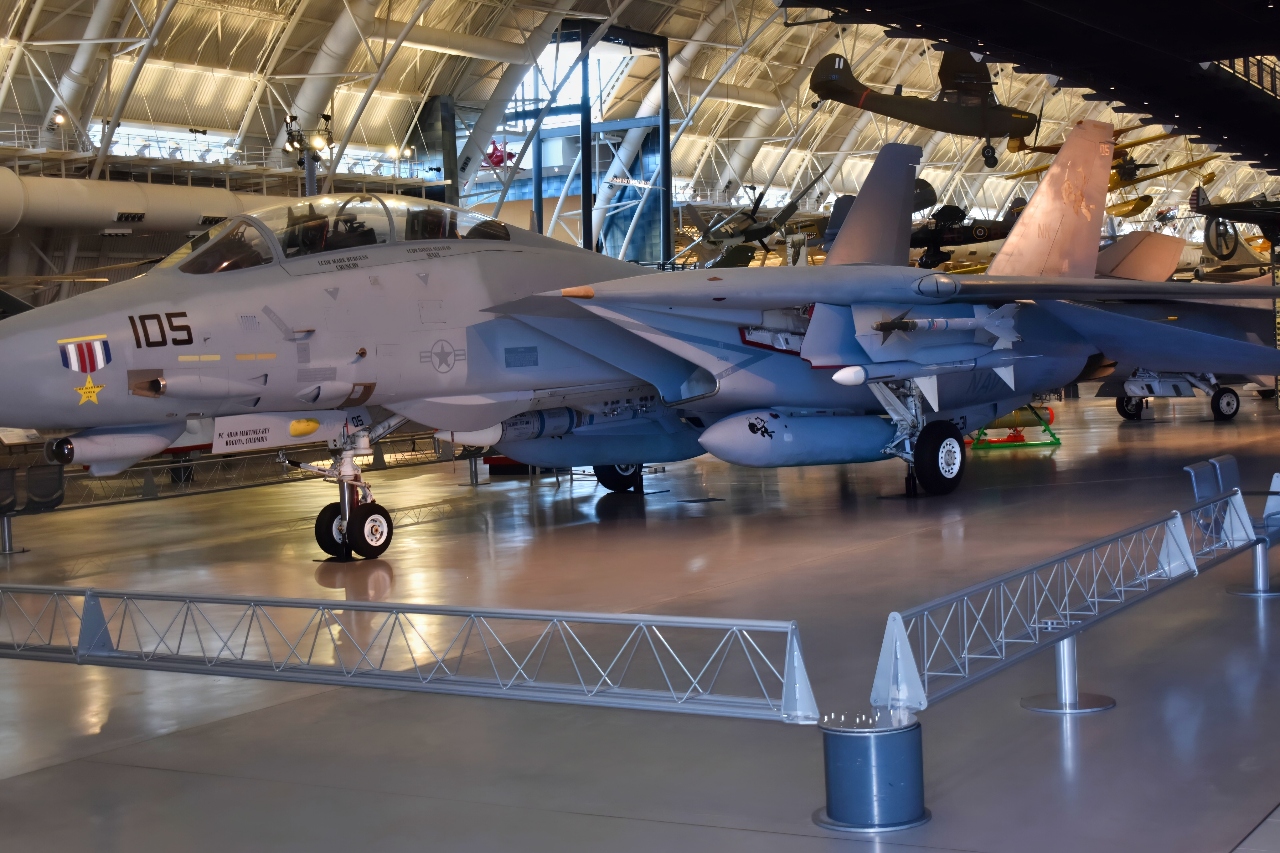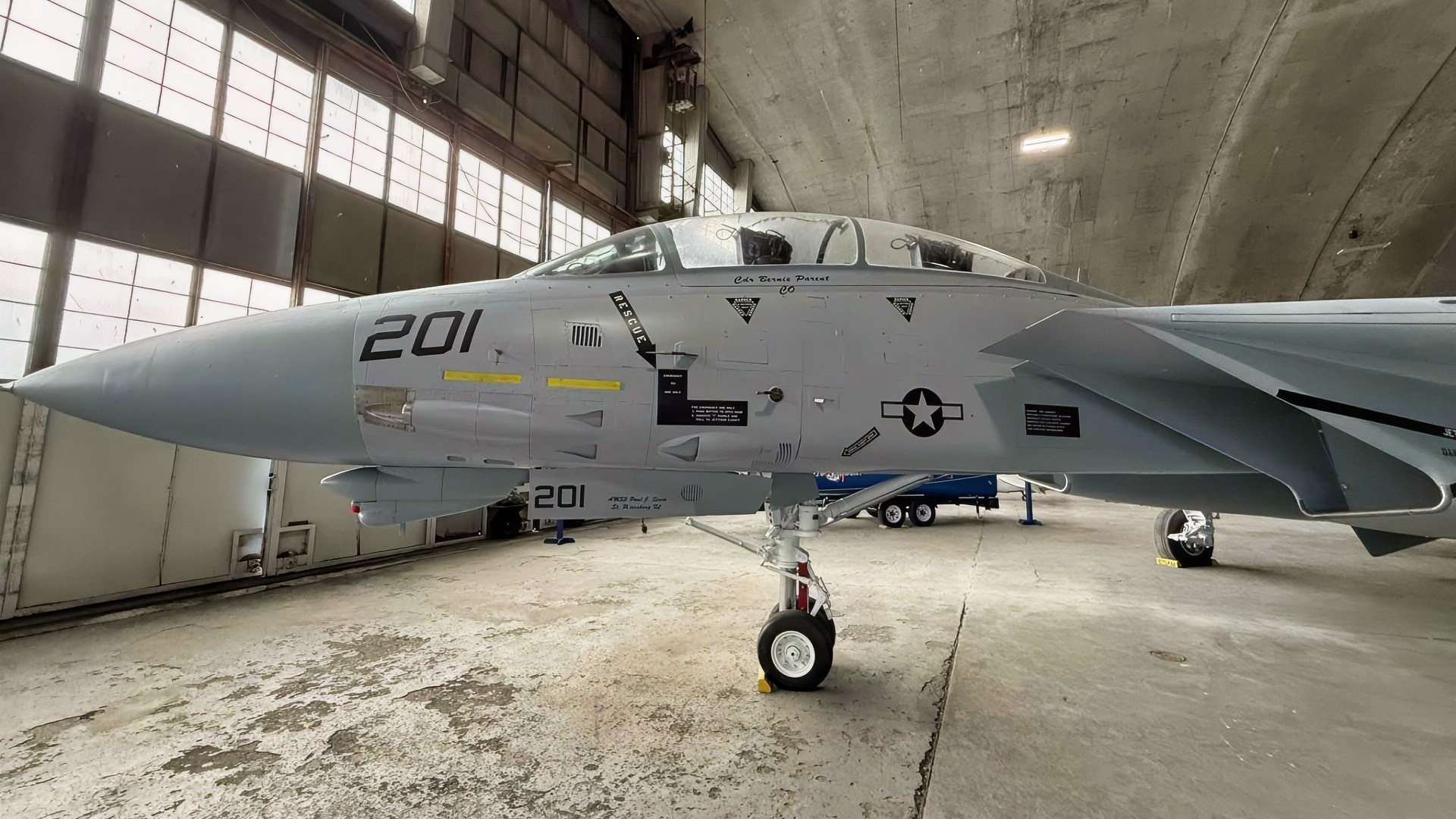Key Points and Summary – The F-14 Tomcat married a superb airframe to the wrong engine. Inherited from the F-111, Pratt & Whitney TF30s were prone to compressor stalls at high AoA and abrupt throttle changes—exactly where a carrier dogfighter lives.
-For years, the Navy ate soaring maintenance and readiness hits until GE’s F110-GE-400 arrived in 1988, adding 30% more thrust, slashing upkeep, and birthing the F-14A+ (B) and F-14D.

F-14 Tomcat. Image Credit: Jack Buckby/National Security Journal.

F-14 Tomcat Photo Taken on August 24 2025. Image Credit: Jack Buckby/National Security Journal.
The lesson endures: propulsion can make—or break—programs.
-It’s why the F-35’s F135 sustainment burden matters, why B-52J re-engining targets lifecycle costs, and why NGAD’s adaptive engine is tuned for thermal management from day one.
How the F-14 Tomcat’s Bad Engines Changed the Game
The Grumman F-14 Tomcat is one of the most famous aircraft in the world. It’s a Cold War icon, a Hollywood legend, and a capable twin-engine fighter aircraft that dominated the skies from the mid-1970s to the early 2000s.
Yet behind that reputation lay a major flaw that shaped the platform’s entire career: its engines.
The Tomcat’s early Pratt & Whitney TF30 turbofans were never designed for a carrier-based dogfighter, and the U.S. Navy was reminded of that regularly as they sought to make it work.
For two decades, the Navy was tasked with dealing with compressor stalls, high maintenance burdens, and rising sustainment costs – all of which proved that the engine was never right to begin with.
In time, the Tomcat did get the engine it always needed, but the delay should offer a lesson to planners and engineers of today that engine choice can make or break a weapons program. And, it’s not just about performance.
The wrong engine can cause delays, readiness gaps, and rising cost per flight hour. The Tomcat’s story is perhaps one of the best case studies in how propulsion problems can overshadow a hugely capable airframe.
The Fighter With the Wrong Engines
The Tomcat’s original TF30 engine was built for the F-111 Aardvark—a very different aircraft with handling demands that are by no means comparable to those of the Tomcat.

F-111. Image Credit: Creative Commons.
The Aardvark was a supersonic, twin-engine, tactical strike aircraft and bomber designed for long-range, low-level, high-speed penetration while carrying heavy payloads.
The Tomcat, however, was a fleet air-defense fighter.
That meant it was designed to be a high-agility, carrier-based dogfighter.
The Tomcat was designed for rapid response and high performance, while the Aardvark was better suited to stable, low-altitude flights and predictable handling.
See the problem?
The Tomcat was inherited only under political and budgetary pressure following the collapse of the F-111B program in the late 1960s.
From the very beginning, the engine didn’t really make sense for a high-agility fighter. The TF30’s biggest flaw was its notorious susceptibility to compressor stalls—a disruption of airflow in the compressor—at high angles of attack or during rapid throttle movements.
Those conditions were common while flying the Tomcat, because that’s precisely the kind of maneuvering and performance it was designed to achieve.
The Navy itself documented this behavior, noting over the years that the stalls could cause spins or loss of control.
But for decades, nothing could be done. Pilots were forced to deal with the engine’s problems.
And so, despite Tomcat’s world-class avionics, weapons, and aerodynamic design, its performance hindered it.
All because the engine didn’t belong in the airframe.
A Long Road to A New Engine
Between sustainment and performance, the Navy knew something needed to be done.
Multiple internal proposals recommended re-engining the Tomcat throughout the 1970s and early 1980s.
Still, the Navy struggled to fund the upgrade while simultaneously investing in the F/A-18 program and other major shipbuilding priorities.
Instead, the Navy was forced to adopt incremental upgrades before eventually securing Department of Defense support for the procurement of the General Electric F110-GE-400 engine.
By 1988, these new engines were adopted, solving the reliability problems that plagued the Tomcat.

F-14D Tomcat. Image Taken By National Security Journal.
The new engines also offered almost 30% more thrust.
The General Electric engine also significantly reduced maintenance hours per flight and also improved sortie generation rates.
The engine was adopted for the F-14A Plus variant (later known as the F-14B) and later for the F-14D.
The engine problem was finally fixed, but only after the famous platform spent 15 years operating with engines the Navy never wanted in the first place.
Important Lessons for Today
The Tomcat’s engine saga is a curious piece of history, but it also serves as a lesson for today’s programs.
Modern fighters are more advanced in virtually every way, but they are thoroughly useless without an engine that works.
And by “works,” I mean more than simply “makes the aircraft fly.”
An engine must be cost-effective, deliver the necessary thrust, be suited to the airframe, and not require excessive maintenance.
For example, the F135 engine in the F-35 is one of the most significant cost drivers in the F-35 sustainment systems, according to the Government Accountability Office.
This is a problem that’s hard to beat. The B-52J re-engining effort – which will see the airframes fitted with new Rolls-Royce F130 engines – is specifically intended to reduce life-cycle cost and maintenance time.
With the Next Generation Air Dominance (NGAD) program, these kinds of problems may finally be addressed before they arise.
The next-generation fighter’s new adaptive-cycle engine is being designed explicitly around thermal management and sustainment from day one. The F-14 proves why this matters, and it may have even paved the way for better engines.
From this perspective, the Tomcat is an icon in yet another way. It’s a Hollywood and Cold War legend that dominated the skies despite its flaws, paving the way for next-generation systems.
About the Author:
Jack Buckby is a British author, counter-extremism researcher, and journalist based in New York. Reporting on the U.K., Europe, and the U.S., he works to analyze and understand left-wing and right-wing radicalization, and reports on Western governments’ approaches to the pressing issues of today. His books and research papers explore these themes and propose pragmatic solutions to our increasingly polarized society. His latest book is The Truth Teller: RFK Jr. and the Case for a Post-Partisan Presidency.
More Military
Russia’s Mach 2 Su-30SM Fighter Has A Message for Any Air Force on Earth
The Mach 2.2 B-1A Bomber Has A Message for the U.S. Air Force
The Mach 2.35 ‘Super’ Eurofighter Typhoon Fighter Has a Message for Any Air Force On Earth
Canada’s CF-18 Hornet Fighter Crisis
Forget NGAD or the J-20: A 7th Generation Fighter Could Hit Mach 5










